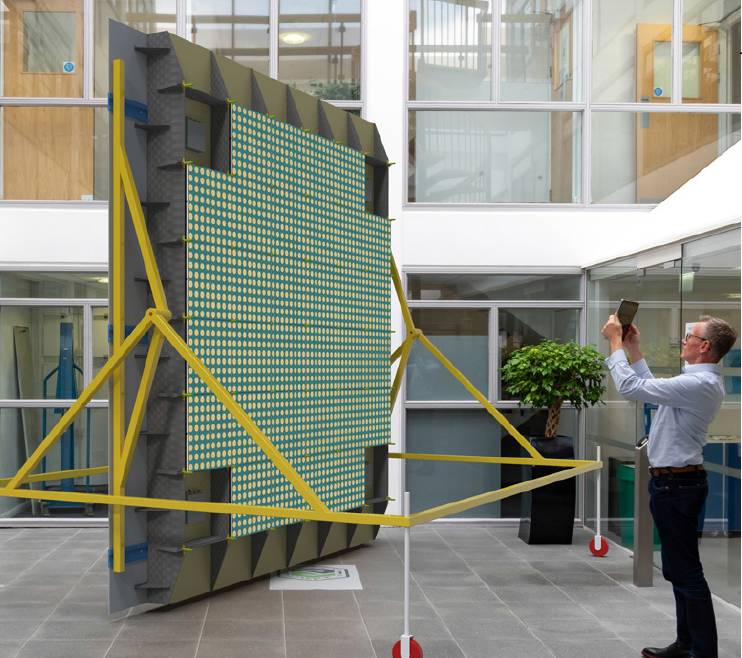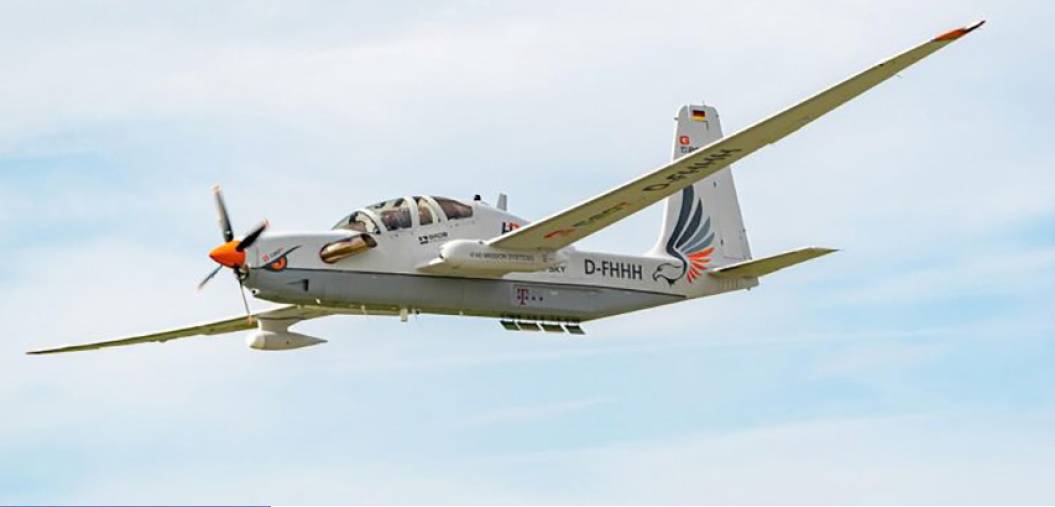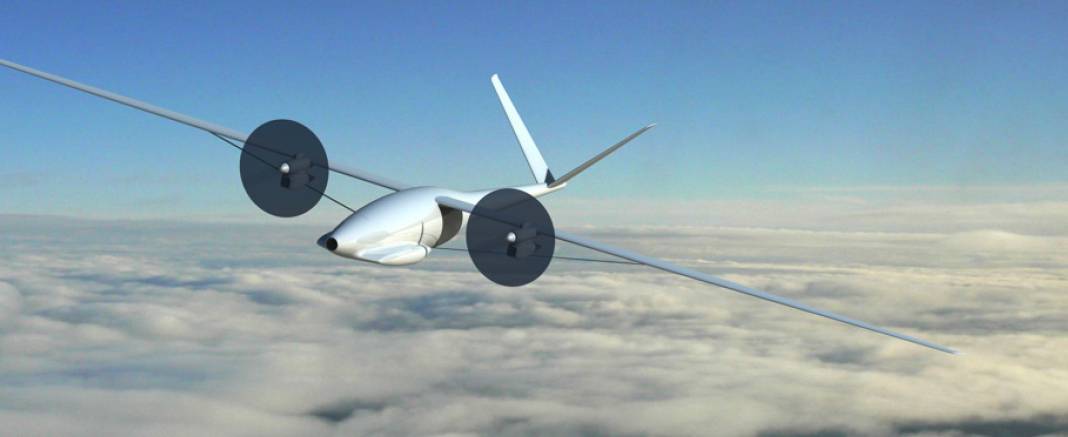AEROSPACE High altitude pseudo-satellites
Get ready for 5G from the stratosphere
A new UK company has emerged from stealth mode to unveil a plan for a hydrogen-fuel cell-powered high-altitude pseudo-satellite (HAPS) UAV with the biggest-ever civil antenna to bring ultra-fast 5G connectivity from the skies. TIM ROBINSON FRAeS reports.
 Stratospheric Platforms’ visualisation of its 60m wingspan HAPS. Stratospheroic Platforms
Stratospheric Platforms’ visualisation of its 60m wingspan HAPS. Stratospheroic Platforms
On 19 October a secretive Cambridge-based UK start-up, Stratospheric Platforms, went public and revealed that it had conducted a flight trial with its partner and shareholder, Germany’s Deutsche Telekom, to demonstrate connectivity for a ‘4G/5G mast in the sky’. The test was the world’s first successful trial of high-speed LTE/4G data and voice connectivity using a remotely-piloted aerial system (RPAS) and integrated into a terrestrial phone and data network. The trial, using a high-altitude Grob 520 aircraft acting as a surrogate RPAS at 45,000ft over Bavaria, was a proof of concept for an ambitious and highly innovative project to deliver high-speed broadband and data from the sky.
The company, which was formed in 2014, is currently developing a hydrogen-fuel cell-powered HAPS UAV, with a wingspan similar to that of a jumbo jet (60m), that would fly at 60,000ft to provide ultrafast connectivity for nine-day periods at a time, with a payload of 140kg.
As well as Deutsch Telekom, Stratospheric Platforms has some other well-known names involved as partners, such as Scaled Composites, QinetiQ, Bombardier Belfast, Thales, NATS, TWI and Cranfield Aerospace Solutions. “The number of partners means that it was getting increasingly difficult to keep it under wraps,” jokes Richard Deakin, CEO of Stratospheric Platforms and a former head of the UK’s NATS air traffic service provider.
HAPS – benefits and challenges
The idea of HAPS (high-altitude pseudo-satellites) platforms has been growing in popularity for a while now, with the UK emerging as a leading centre for this development. HAPS UAVs, cruising above weather and commercial air traffic at 60-70,000ft promise satellite-like capability but at a fraction of the cost of spacecraft and can ‘dwell’ over areas or regions for extended periods of time, to deliver persistent surveillance or connectivity. Airbus’ Zephyr, for example, still holds the world aeronautical record for absolute endurance at 26 days. BAE Systems’ PHASA-35 meanwhile is chasing this record and with the goal of staying aloft for an entire year. Meanwhile, over in the US, AeroVironment recently flew its SunGlider HAPS, in a 20hr test flight. Along with Google’s Loon Balloons and ThalesAleniaSpace’s Stratobus, which use lighter-than-air platforms, HAPS is becoming an exciting new frontier in aerospace.
 What if you used the same principles to link radio telescopes – but pointed the antennae downwards? Square Kilometre Array
What if you used the same principles to link radio telescopes – but pointed the antennae downwards? Square Kilometre Array
Unlike satellites, HAPS can also be reflown and refitted with new sensors and technology. It is thus no wonder that HAPS is attracting attention for both civil and military roles in communications relay, surveillance, disaster relief and ISR roles.
However, all these platforms above use solar power. This, in theory, makes for (almost) infinite flight once airborne but also brings challenges. First, solar panels only produce a tiny amount of power (approximately 200w for Zephyr) and this means that payloads are limited. The super-lightweight construction of these UAVs also limits the size and weight of payloads and sensors, although advances in sensor miniaturisation are increasing capabilities.
Says Deakin: “The problem with literally all the existing HAPs is they are all without exception powered by solar power. That just doesn’t deliver anywhere near the sort of power that you need for a serious telecoms application”.
The super-lightweight design of the solar-powered HAPS also makes for another limitation – getting up to operational altitude above any wind and weather. Airbus has already found this out the hard way, with crashes of its Zephyr air vehicle in Australia. Weather limits for launch and recovery thus becomes a key operational constraint for these class of featherweight UAVs.
Solar power makes for limitations in operating these platforms in extreme northern or southern latitudes, where the slant angle of sunshine delivers even less power.
Meanwhile, on the ground, the forthcoming rollout of 5G broadband connectivity has brought its own challenges – namely the amount of masts that will be needed to bring this ultra-high broadband connectivity. One estimate for the UK is that an additional 400,000 5G masts may be needed to provide the entire British Isles with this next-generation connectivity. This not only brings in its own problems of granting permission and unsightly masts ruining scenic spots but also for telecoms companies, the cost of renting land for these masts starts to mount up. Moving the 5G mast to the sky thus starts to make economic sense. Deutsche Telekom, for example, estimates its land rental costs for masts will drop from €6bn to €1bn by switching to 5G connectivity delivered by HAPS.
 On 21 September, AeroVironment conducted a 20 hour test flight of its solar-powered SunGlider HAPS over New Mexico. AeroVironment
On 21 September, AeroVironment conducted a 20 hour test flight of its solar-powered SunGlider HAPS over New Mexico. AeroVironment
Enter Stratospheric Platforms
These factors above then made for a compelling case for a new entrant in the HAPS sector to deliver a more powerful and capable UAV optimised for the telecoms market. Enter the UK’s Stratospheric Platforms.
Interestingly, the concept for Stratospheric Platforms breakthrough in connectivity comes from astrophysics, or more specifically radio astronomy. In radio astronomy, scientists can now link far-away telescopes to ‘virtually’ increase the size of the dish antenna to one that can be hundreds, or even thousands, of miles across. This vastly increases the resolution of the instruments and has allowed scientists to probe the far reaches of the Universe to detect black holes and other interstellar objects.
However, the same concept can also be turned upside down with antennae pointing at the Earth to create virtual ‘giant’ steerable data relay footprints – by linking antennae on multiple air vehicles together to create one super-massive ‘virtual’ communications antenna. This patented concept of using a synthetic inverse aperture array to do telecoms work or cooperative aerial inter-antenna beamforming (CAIB) provides; “…massive amounts more data” than a single antenna on its own and allows the creation of individual cells for each user, says Stratospheric’s CEO Deakin. Thus, the greater the antenna resolution, the higher the potential data rates per km2. CAIB is the ultimate goal of Stratospheric Platforms and it is pursuing a number of critical technologies to unlock this revolutionary ‘Super 5G mast in the sky’.
The biggest commercial antenna in the sky
 The 3m2 antenna will be the world’s biggest commercial airborne antenna. Stratospheric Platforms
The 3m2 antenna will be the world’s biggest commercial airborne antenna. Stratospheric Platforms
Each air vehicle will boast a giant 3m x 3m aerial on the underside of the aircraft – the biggest-ever commercial aerospace antenna to ever fly and the size of a large garden patio umbrella – “it's a beast” says Deakin. This flat antenna, with 2,048 transceivers, is equivalent to over 200 terrestrial 5G masts and allows direct connectivity of phones, tablets and laptops to the 5G network with blisteringly fast data speeds and latency of only 1m/s. At the UAV's operational altitude of 60,000ft, this translates into a footprint of 140km in diameter.
In addition, the flat antenna is electronically steered so that the beam footprint can follow borders, coastlines or be dynamically adjusted in-flight. It could, for example, add additional bandwidth for sporting or national events with spot beams, or be used to ‘follow’ commuters providing extra bandwidth to the suburbs at the start and end of every day. Flying over the ocean, its electrically-steered beam could theoretically follow cruise ships to give passengers high-speed broadband in the middle of the Atlantic.
Steerable beams are nothing new for the latest generation of telecoms satellites but the altitude that HAPS flies makes a big difference in guaranteeing super-fast connectivity speeds. The ultra-low latency of 1m/s 5G from a HAPS telecoms platform, compared to 25-30m/s connecting with a satellite in low Earth orbit, has other advantages apart from making sure amusing cat videos on TikTok do not buffer. The predicted 5G ‘internet of things’ (IoT) which promises to connect smart fridges to cars etc has some applications where ultra-fast connectivity is not just ‘nice to have’ but could be safety-critical, such as autonomous cars, urban air mobility vehicles or cargo drones. This sort of high-speed broadband platform, with its ability to provide 5G without needing masts or substantial ground infrastructure, may be key in fully unlocking this telecoms and IoT revolution.
Hydrogen power
Stratospheric Platforms has also chosen hydrogen fuel cells rather than solar power for its UAV. This gives shorter endurance than platforms such as Zephyr and PHASA-35 but at the benefit of far greater power available – with 20kW just for the antenna, compared to solar HAPS 200w (of which some must go to provide propulsion). Using hydrogen fuel cells driving two propellers, the UAV will be able to carry a payload of 140kg. In comparison, the Zephyr S can only carry a payload of 5kg. Hydrogen power also allows for 24/7 operations night and day without needing to ‘power-down’ into reduced operations mode, as solar-powered UAVs need to do during the night, as well as flights at extreme northern and southern latitudes.
 A render of the still unnamed HAPS air vehicle currently under development at Scaled Composites in Mojave California. Stratospheric Platforms
A render of the still unnamed HAPS air vehicle currently under development at Scaled Composites in Mojave California. Stratospheric Platforms
The UAV will use liquid hydrogen, as it is one-third of the volume of gaseous volume, keeping the fuselage slim and cutting down on drag. It also can be stored at a lower pressure (4bar compared to 700bar), making for a lighter and structurally simpler container. However, the catch is that the liquid hydrogen will need to be stored at -240ºC. Here too, Stratospheric Platforms is working on still-secret special insulated fuel tank technology which it says will allow it to use liquid hydrogen. To cope with the thin air density at 60,000ft, the propulsion system will also use a four-stage compressor with frictionless air bearings derived from motorsport technology. The hydrogen fuel cell and compressor system has already been tested at simulated stratospheric altitudes, generating up to 49kW of power across a range of flight levels.
Although Stratospheric decided on hydrogen early on, the reveal of its plans right now is particularly timely, given related news from ZeroAvia and Airbus to pursue hydrogen as a green zero-carbon fuel source. The EU itself is keen to massively scale up the production of hydrogen and create a hydrogen fuel infrastructure. This high-level push for decarbonisation of aviation will thus ease and simplify Stratospheric’s passage to regular operations as hydrogen fuel infrastructure starts to be rolled out at airports.
 The Grob 520 was used as a surrogate UAV in the test with Deutsche Telekom. Note laptop-sized aerials under rear fuselage. Deutsche Telekom
The Grob 520 was used as a surrogate UAV in the test with Deutsche Telekom. Note laptop-sized aerials under rear fuselage. Deutsche Telekom
The air vehicle itself
A production prototype of the, as yet unnamed, V-tailed 60m wingspan UAV is now in development at Scaled Composites in the US. Responsible for Voyager, White Knight 2 and Stratolaunch’s ‘Roc’ aircraft, Scaled is probably one of the world’s leading experts in lightweight but ultra-strong carbon-fibre aircraft designs. This construction means that Stratrospheric’s UAV will be far more robust and resilient to wind and weather than the solar-powered class of HAPS.
Crucially, it is also planned to be civil certificated from the start, allowing it to fly and operate through controlled airspace using standard operating procedures – a challenge that Deakin, with his experience as head of UK’s NATS, is well aware of. Up at 60-62,000ft, though, the platform will be above weather and other civil air traffic. Deakin notes that the European Commission is conscious of the growing commercial interest in HAPS and expects that Eurocontrol and others will come together to develop standardised rules for civil HAPS airspace operations in the near future.
Next steps
With a productionised prototype already in development by Scaled Composites, the next steps will involve testing the giant 3m x 3m 5G antenna. While the most recent test used a 4G/LTE antenna on a Grob 540, Deakin says that the company has yet to decide which platform may be used to test fly this larger antenna and observes that its partner, Scaled Composites, also has access to high-altitude demonstrator aircraft. First flight of the UAV prototype is scheduled for 2022 and the system could be in service by 2024. Stratospheric says it is interested in ‘creating the ecosystem’ for this platform and technology, licensing it for others, rather than operating it themselves as a service provider.
 The composite V-tailed air vehicle, which has the wingspan of a 747 is being built by Scaled Composites. Stratospheric Platforms
The composite V-tailed air vehicle, which has the wingspan of a 747 is being built by Scaled Composites. Stratospheric Platforms
There is also no doubt that, while the civil telecoms application is the company’s primary focus, the 24/7 capabilities, high power and payload and potentially using several together to create bigger and more powerful ‘virtual antenna’, could also have other applications in disaster relief, border patrol or for military customers. Could, for example, this ‘virtual array’ produce a new system capable of detecting stealth aircraft at long range or a highly accurate next-gen SIGINT/ELINT network? Says Deakin: “We’ve built, designed, marketed and developed this very much for telecoms applications but, when you have a platform at that height, with that power, for that endurance, there are quite a few interesting things that you could do with it other than just telecoms. There has been a lot of interest from communities outside of the civil telecoms world.”
Summary
Stratospheric Platforms’ UAV may not break any records for endurance, compared to the ultra persistent solar-powered HAPS that is aiming for months aloft. However, its nine-day loiter time may be the sweet spot for persistence in many roles and is more than offset by its staggering antenna capabilities and electric power reserves. Stratospheric’s phase two-goal, to link individual UAVs together to create a giant ‘synthetic antenna’ with CAIB, would be a truly breakthrough technology in airborne data communications and may well be a key enabler to bring the benefits of 5G to everyone.
 Stratospheric Platforms’ visualisation of its 60m wingspan HAPS. Stratospheroic Platforms
Stratospheric Platforms’ visualisation of its 60m wingspan HAPS. Stratospheroic Platforms What if you used the same principles to link radio telescopes – but pointed the antennae downwards? Square Kilometre Array
What if you used the same principles to link radio telescopes – but pointed the antennae downwards? Square Kilometre Array



